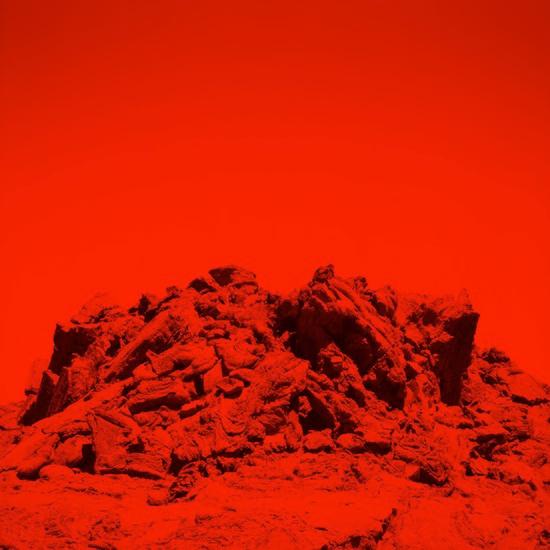Mondkopf - Hadès

Something’s terribly right with this record and until now I couldn’t really put my finger on it. Upon my last listen of the title track (Hadès I), I had a modest epiphany. This record works on so many levels for me that I somehow had to get my thoughts straight and write something about it, piling up on the reviews that blossom here and there.
You may want to click play before reading this thing.
I may first tell you what I think this record is not. It’s not a techno album. Nor is it an ambient album. It is electronic though – and that’s about all I can say about it. It’s electronic and austere, baroque and strict. Kicks and claps scarcely happen and somehow do not seem very related; they sound more like solo instruments, extremely processed and refined, rather than foundations for the tracks. The whole thing is laced with powerful textures and drones, the kind that breaks ribs and causes pneumo-thorax. Some tracks are clearly meant to be experienced in a club rather than listened to on headphones or even a decent pair of speakers (“Cause and Cure” and “Immolate” are just tailored for Régimbeau’s live-sets, with rhythmic patterns reminiscent of his previous efforts on In Paradisum or Perc Trax, and filter progressions designed to make a crowd go wild). Some other tracks provide balance and depth for less functional listening. The three-part title piece makes for an impressive trip, and is alone worth the price of the record. Some other tracks like “Here comes the Whispers” pay homage to the producer’s first records, that were drenched in nostalgic false naivety.
But there is something else to it, more personal maybe, something that connects deeply to my musical roots and that appeals both to the late teenager in me as well as the more serious young adult.
There are evident connections between this record and records that were (and still are) cornerstones of my musical taste. The record, although very well produced, feels very much like a bedroom/garage production – in a good way. It is thrifty and rich at the same time and punk in essence. It is dark and doomy and still full of light – and not just bleak. It reminds me so much of two other records I love that I think I should risk a comparison.
The first record I thought of was Mayhem’s first release, the “Deathcrush” LP. The opening track reminds me of a lot of things – Martin Hannett’s intro of a Joy Division track, some black metal records that I still love (Blut Aus Nord, some Burzum maybe). But most of all it reminds me of the opening track of the Deathcrush album. It has a macabre feel to it and just generally feels weird, somewhat out of place for a black metal album. Legend has it the band asked Tangerine Dream’s Conrad Schnitzler for an intro track and that he gave them this.
[su_youtube url=”http://www.youtube.com/watch?v=0kdKQEzHnxs”]http://www.youtube.com/watch?v=GSGKEy8vHqg[/su_youtube]The piece is just a cleverly programmed drum track. But I can definitely hear some clues in Mondkopf’s record, pointing to that kind of technique and referencing black metal – hell, even the cover art looks familiar ! (okay that last sentence may need revision but you get the idea). Drum programming is clever indeed and the broken beats carry some serious weight. The snare rolls on “The Stars Are Falling” remind me a lot of Schnitzler’s track and the overall feel of the album stands somewhere between the current industrial trend that we hear in techno music and droney black metal by the likes of Xasthur/Leviathan, Darkspace and Blut Aus Nord (Ultima Thulee mostly). The sheer amount of distortion on the tracks shows that Mondkopf has lost no appetite for extremely digital textures, a signature that can be heard all the way back to his very first productions.
The other record that sprung to my mind was the Funeral Music For Queen Mary by Henry Purcell – especially the March and the Canzonna. The piece is best enjoyed when played on period instruments. Trumpets and sackbuts of the 17th century had a very sour tone that can be heard on some modern recordings of the piece. The Hadès tracks echoed just that in my mind, as well as the trumpets rolls in Hadès II and the very baroque tones heard in some places throughout the album. Of course, as in almost every Mondkopf record, there is a choir near the end, whose childish accents rooted the impression deeper in my mind. The record feels like waking up from a terrible nightmare in the safety of one’s bed, like that moment when the chill is leaving your spine while you force yourself to ease down and forget about it.
[su_youtube url=”http://www.youtube.com/watch?v=HghLiJKFvmc”]http://www.youtube.com/watch?v=GSGKEy8vHqg[/su_youtube]A reviewer on the Drone website wished that Régimbeau would only listen to Wagner pieces for a time. I’m not so sure. Seeing how his music changed in a little more than five years, I would rather have him take me wherever he’s willing to go. But I certainly would agree with him that this album falls into a category of its own.
Buy this beauty here
